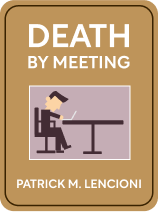

This article is an excerpt from the Shortform book guide to "Death By Meeting" by Patrick M. Lencioni. Shortform has the world's best summaries and analyses of books you should be reading.
Like this article? Sign up for a free trial here .
Do you want to know how to have productive team meetings at work? What are the top three flaws with the modern-day business meeting model?
There are three significant issues with most meetings: a lack of drama, a lack of structure, and a lack of frequency. Here you will learn how to fix these issues and make your business meetings more productive and engaging with tips from Death by Meeting.
Keep reading for tips on how to have more productive team meetings from Death by Meeting.
How to Have Productive Team Meetings
Meetings are the lifeblood of an organization—they are central to its success but are also often seemingly unproductive and too long. This presents a paradox—how should companies move forward with critical meetings that the staff see as pointless? The answer is to make meetings better. Death By Meeting provides a roadmap to have productive team meetings and a parable that explains exactly why this task is so important.
There are three significant issues with most meetings: a lack of drama, a lack of structure, and a lack of frequency.
Problem #1: No Drama at the Team Meetings
Team meetings are tedious. Given that most people sitting through meetings have other work that they could be doing, this is a huge issue, and it makes most employees resent meetings as a waste of their time. Meetings are tedious and unproductive because there is no drama or tension within most meetings. In fact, most meeting leaders skirt tension if it exists.
Solutions
To solve this problem, actively look for disagreement or drama. This keeps meeting participants engaged and leads to important strategic discussions. If two people have a disagreement, backed up by data, it’s helpful for everyone to hear it, because it engages them and helps them form their own opinions about the company’s decisions.
Think about a great screenplay. Screenwriters develop conflict and resolution over two hours. There are different kinds of conflict—from man versus a system in a movie like A Few Good Men to man versus nature, an unseen enemy, and himself in Apocalypse Now. Like movies, meetings often last two hours, but they lack everything that makes movies enjoyable, when in fact, meetings should be more fun than watching a movie.
- You can interrupt the action at a meeting. If someone has a point that you disagree with, you can engage them in discussion.
- Meetings are more relevant to our daily lives. They determine, in part, what we’ll be working on, how happy we are at work, how productive our work environment is, how much money we make, and how long our hours are.
Find a Hook
In every good movie, conflict starts within the first ten minutes. This is called the “hook”—it’s what draws people into the movie and makes them want to keep watching. A good meeting works the same way. A hook can take many forms, but it should explain the stakes. As the meeting leader, explain that the company is under threat, or that it’s struggling to make a dent in a new market, or that a bad decision could lead to these problems. Or, if you don’t want to start on a negative note, explain how a good decision could make life better for employees, clients, or the world.
Employees need a reason to care. Finding a hook is easy, because as we’ve illustrated, meetings do matter. They decide the direction of a company.
Find Conflict
After you’ve explained the stakes, look for disagreement. If there’s a group of reasonably smart people discussing an issue that they all care about (because of the hook), they’ll disagree on at least a small part of it. If you hear disagreement, or even see on someone’s face that they’re unhappy with what’s going on, explore that. While people are often conflict-avoidant, when they do address an issue, they’ll almost always feel better, even if the ultimate decision doesn’t go their way.
Tell the team that you want conflict in meetings. However, people may still feel uncomfortable attacking their colleagues whom they respect. As a meeting leader, remind the team that what they’re doing is positive. Just a little bit of positive reinforcement goes a long way toward resolving tensions that could otherwise become personal and encouraging participants to have different opinions.
Problem #2: Poor Structure for Meetings
Meetings are unproductive. They don’t yield any results that make people’s jobs easier or help the company make a big decision, so again, employees begin to resent them. This is because meetings are unfocused. People talk about various issues that don’t relate to one another. Most issues get short shrift while the team discusses others for far too long.
Usually, meetings work as follows. The boss schedules them for two hours. Before the meeting, the leader sends out a disparate agenda that includes somewhere between four and seven items to discuss. She solicits feedback on the agenda but gets none. The first couple of topics (not necessarily the most important) take up the lion’s share of the two hours, and the team rushes through the rest. The team makes no decisions and everyone leaves disappointed and defeated, if not outright angry.
- Someone is upset that the meeting went late.
- Another person is mad that the group didn’t address his issue in full.
- Another person was more frustrated by the administrative issues discussed and wanted more strategic talk.
- Yet another had the opposite problem and found that they spent so much time brainstorming that they didn’t have enough time to go through important logistics related to her job.
- Everyone is annoyed at the leader.
Think of these meetings like a stew filled with leftovers. The team chucks everything into the pot, without much regard or care for what’s going in there. Because the meetings are inefficient, the leader attempts to schedule fewer of them, which makes them even more inefficient. The team discusses everything all at once.
Solutions for Team Meetings
To solve problem two, leaders need to develop multiple types of meetings, with different purposes, formats, and uses. There are four different types of meetings.
The Check-In
This is the shortest meeting. It happens for five minutes at the beginning of each workday and is purely logistical: Who is here, who isn’t, and what everyone is working on today. Often, at the beginning of implementation, team members don’t find this meeting important, because it’s so fast. But it is an essential building block to better and more efficient communication—make sure it’s clear that this meeting is required.
Never cancel the meeting and keep it to five minutes at most. Don’t address anything beyond simple logistics here—other, larger problems can wait for the other meetings. People don’t even need to sit down for the check-in.
The Tactical
This meeting happens every week or every other week and lasts for around an hour. 45 minutes is a shorter tactical and 90 minutes is a longer one. It starts with everyone going around and explaining, in under a minute, what they’re working on. After everyone knows what’s going on with everyone else, you and anyone you deputize gives updates on some larger logistical issues—how does the budget look, is the team hitting their sales goals, what is the team spending on advertising, and on from there.
Only then does the team create an agenda—this way, the agenda is based on what is actually going on at the company as reported by everyone involved. Address short term tactical challenges at this meeting, like whether to increase advertising for the month or whether to hire someone new. This meeting is meant to resolve and clarify short term obstacles to the company.
These tactical meetings don’t get into long-term strategic questions. Those are reserved for the next meeting.
The Strategic
This meeting is about large-scale strategies decisions. It happens every month or so and lasts anywhere from two to four hours. Sometimes, the timeline can change if a big strategic decision must happen right away. In this case, you can call an ad hoc strategic meeting. In both the ad hoc and the regular strategic meeting, though, this meeting is the one that will likely involve the most conflict and the one that can thus be the most fun.
Only the most salient questions are at issue in the strategic meeting—limit the agenda to two to three big questions. A lot of strategic questions will likely come up in the weekly tactical meetings, such as whether to expand into a new market or who advertisements are targeting, but prioritize the strategic questions they deem most important.
Additionally, everyone must come prepared with research. Conflicts, as previously discussed, are the lifeblood of these meetings, but if people arguing with one another don’t have data to back up their points, the conflict isn’t productive.
The Review
The final meeting is the review, which takes place about once a quarter off-site. Many companies do corporate retreats already, but these can function much better. They shouldn’t just function as a getaway. Rather, they involve long, important discussions about the direction of the business.
First, executives consider the direction of the company. They’ll review their strategic meetings and ask if their decision-making process has led to positive outcomes. They can also think about new challenges to their industry. This is where executives can get together and discuss the direction of their business or a new competitor eating into their market share in depth. Additionally, executives should assess their own performance and the performance of important employees.
These meetings aren’t too structured—the team can go into the off-site review with a basic understanding of some topics that they want to cover, but they don’t need a comprehensive agenda or a cutoff point. They don’t need hours of PowerPoints that often dominate these sessions. Finally, don’t include outsiders, like the family of the participants. It might seem fun to socialize, but this changes how the team interacts with one another, which is counterproductive to success.
Problem #3: Too Few Productive Team Meetings
In general, if there are too few meetings, executives spend most of their time answering questions about logistics. In a big company, this can entirely consume an executive’s day. So these four types of meetings can actually significantly reduce meeting-like logistical activity during the rest of the day. If everyone gets on the same page, things will run much more smoothly.

———End of Preview———
Like what you just read? Read the rest of the world's best book summary and analysis of Patrick M. Lencioni's "Death By Meeting" at Shortform .
Here's what you'll find in our full Death By Meeting summary :
- Why are meetings so important and detrimental at the same time
- The top 3 issues that commonly plague meetings
- Why a meeting where participants disagree can be a good thing






